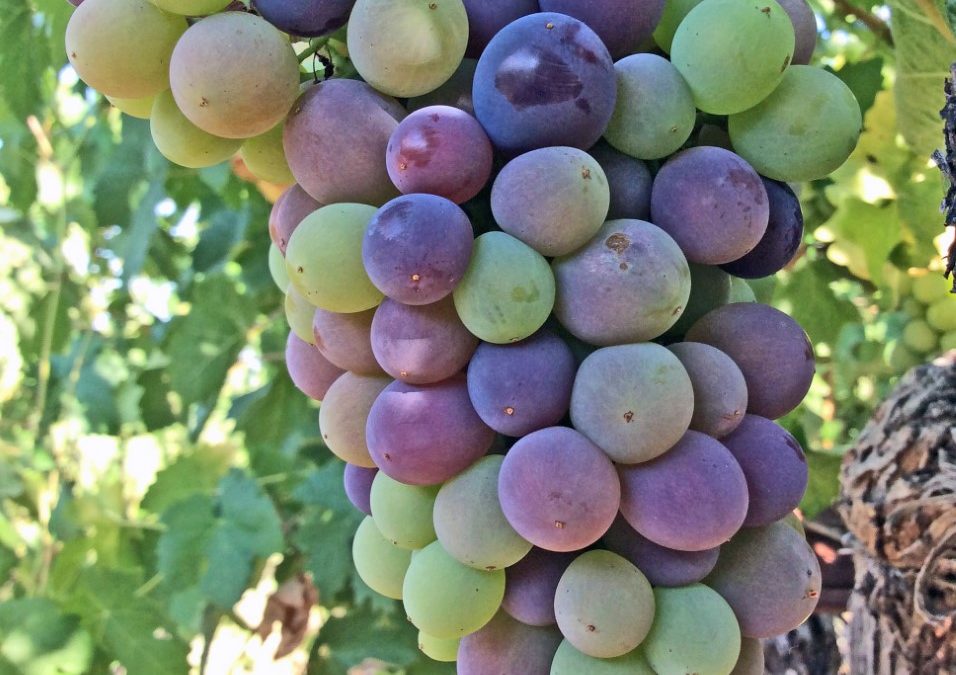JULY 6, 2020. BY STAN GRANT, VITICULTURIST.
The ripening period is the home stretch of the growing season. During this time, grape berries experience dramatic physical and chemical changes as they transition from hard, green, acidic, and unpalatable to soft, pigmented, sweet, and flavorful. These changes and continued berry expansion draw heavily on internal vine resources, creating what has been termed crop stress. After ripening begins, the viticultural focus is supplementing resources and protecting vines as needed to sustain their ripening functions. Before turning our attention to the ripening period vineyard management, we need some background.
Ripening Events and Definitions
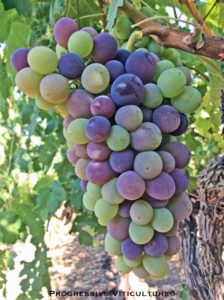
Fig. 1. Berries becoming purple indicate the onset of ripening for Syrah. (Progressive Viticulture©)
In the wine industry, we refer to the onset of ripening as veraison. It is evident visually as changes in grape color due to the appearance of pigments in grape skins. For white wine grape varieties, berries begin yellowing as chloroplasts cease functioning and carotenoid pigments become visible, while for red wine varieties, blue, purple, and red anthocyanin pigments are synthesized and begin to accumulate (Fig. 1). The first indicator of ripening, however, is not visible because it occurs inside the berries. It is the onset of seed hardening, which begins a number of days before the beginning of coloration.
While the onset of ripening is clear, the end is often less so. The fruit is mature when the seeds are viable and fruit achieves maturity before reaching ripeness.
After achieving maturity, berries ripen as they age (senesce), becoming softer and more intensely colored, flavored, and aromatic. The fruit is ripe when in its optimum physical and chemical state for its intended use. Ripeness, therefore, is subjective and usually is at the discretion of the grape buyer and/or winemaker (Fig. 2). Decisions regarding ripeness and harvest scheduling impact grape quality, susceptibility to mechanical damage and disease, and yield, which declines after the fruit reaches about 20o to 22o Brix. These vineyard management decisions are among the most important made during the growing season.
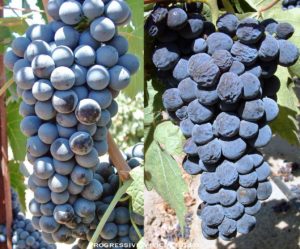
Fig. 2. Either of these two clusters may be ripe depending on the opinion of the one scheduling harvest. (Progressive Viticulture©)
Ripening Period Management Goals
As vineyard managers, we must be mindful that fruit maturation (seed viability) is essential to grapevine reproduction and survival of the species, but fruit ripening is not. As such, the secondary compounds of vine metabolism, including most color, flavor, and aroma compounds, are of lesser importance to vine reproduction. Their function simply is to draw fruit consumers who serve as seed dispersal agents. It is our job to induce vines to maximize the production of desirable sensory attributes.
To do so, we balance fruit and foliage growth, impose moderate water stress, and expose the fruit zone to dappled sunlight as soon as possible after fruit set. Achieving these vineyard attributes is the focus of post-bloom rather than ripening period activities (lodigrowers.com/post-bloom-vineyard-management/). However, for them to be most effective, they must be maintained through ripening (Fig. 3).
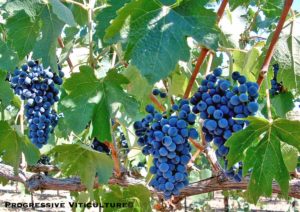
Fig. 3. Balanced fruit and foliage growth, fruit zone exposure to dappled sunlight, and sustained moderate water stress evident in the Syrah fruit zone during the ripening period. (Progressive Viticulture©)
Ripening Indicators
If all is working well in the vineyard with regard to ripening, grapevine stems will yellow and to some extent, become woody (lignify) prior to or during veraison. Under the most favorable ripening conditions, wood on the basal portion of the main stem will ripen ahead of veraison. The main stem is ripe when the area beneath the petiole is woody and woody tissue adheres to the base of the petiole (Fig. 4).
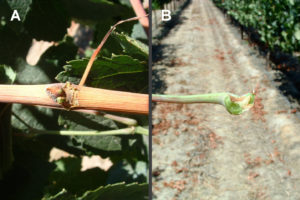
Fig. 4. Ripe Syrah cane wood apparent in (A) a woody leaf scar on a cane and (B) woody tissue attached to the base of a petiole. (Progressive Viticulture©)
Timely stem yellowing and lignification are positive indicators for moderate water stress, growth balance, fruit zone exposure to sunlight, and ample internal resources. On the other hand, green stems in combination with an abundance of succulent apical leaves indicate vines are still chiefly in a vegetative, rather than in a reproductive mode, and that ripening may be impaired and slow.
Ripening Resources
During ripening, berry development draws heavily on supplies of resources available internally within vines and in the vineyard root zone. Berries take in water from the soil until they reach conventional ripeness. They also draw in the majority of the sugar produced in leaves.
Potassium in the berries helps to drive the intake of sugars. Much of this potassium originated elsewhere in the vine, but some came from the soil. Vegetative tissues are also sources for other macronutrients (nitrogen, phosphorus, calcium, magnesium) that accumulate in berries, but supplies also depend on continued uptake from the soil.
Given the importance of mineral nutrient remobilization, it is important to enter the ripening period with well-nourished vines. To ascertain the nutrient status of the vines for ripening, collect leaf tissue samples during veraison and submit them for analysis. Such samples consist of leaf blades or petioles from the most recently fully expanded, mature leaf, which typically is found 5 to 10 nodes below the shoot apex.
Ripening Stresses
During ripening, we expect vines to perform under stress – that is, under some degree of crop stress and moderate water stress. Under these conditions, there are serious risks of other associated, undesirable stresses and at the same time, there is little tolerance for them.
Carefully schedule irrigations to avoid severe water stress, which damages leaves and berries, and reduces sugar production (Fig. 5). The warm leaves of water-stressed vines also encourage pest mites, which may require treatment. Temporarily suspend deficit irrigation schedules and liberally irrigate ahead of, during, and for a couple of days after triple-digit maximum temperatures to minimize heat stress and ultraviolet radiation damage to foliage and fruit.
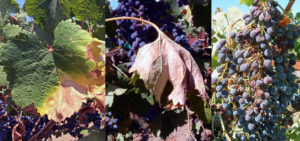
Fig. 5. Severe water stress evident in leaf and cluster damage. (Progressive Viticulture©)
Limiting soil and vine water to induce moderate water stress also limits the movement of mineral nutrients in the soil and in the vines. Under these conditions, low rate fertigations are often beneficial. For example, low rate potassium applications sometimes enhance sugar accumulation in berries, especially for vines carrying large crops. In some instances, ripening period nitrogen applications at low rates can enhance leaf health and photosynthesis, especially after periods of high maximum temperatures.
To Summarize
The viticultural foundations for ripening were set through vineyard management activities earlier in the growing season so that during the ripening period, the primary vineyard management goal is the maintenance of vine ripening functions through supplemental inputs and protective actions.
This a modified version of an article published in the Mid Valley Agricultural Services July, 2012 newsletter. The article was updated for this blog post.
Further Reading
Bisson, L. In search of optimal grape maturity. Practical Winery & Vineyard. 23,32,34,36,38,40,42-43. July/August 2001.
Galet, P. General Viticulture. Oneoplurimedia, Chateau de Chaintre, France, 2000.
Grant, S. Extended wine grape ripening. Practical Winery and Vineyard. 38 (3); 26-37. Jul/Aug 2006.
Grant, S. Post bloom vineyard management. Lodi Winegrape Commission Coffee Shop. (www.lodigrowers.com). May 11, 2020.
Keller, M. The science of grapevines. Academic Press, Burlington, MA. 2010
Kennedy, JA; Matthews, MA; Waterhouse, AL. Changes in grape seed polyphenols during fruit ripening. Phytochemistry. 55, 77-85, 2000.
Kennedy, J. Understanding grape berry development. Practical Winery and Vineyard. Jul/Aug02.
Mullins, MG; Bouquet, A; Williams, LE. Biology of the grapevine. Cambridge Univ. Press. 1992.
Smart, R: Robinson, M. Sunlight into wine: A Handbook for Winegrape Canopy Management. Winetitles, Adelaide. 1991.
Westwood, MN. Temperate zone Pomology – physiology and culture. Timber Press, Portland, Oregon, 1993.
Winkler, AJ; Cook, JA; Kliewer, MK; Lider, LA. General Viticulture. Univ. Calif. Press, Berkeley, 1974.
Have something interesting to say? Consider writing a guest blog article!
To subscribe to the Coffee Shop Blog, send an email to stephanie@lodiwine.com with the subject “blog subscribe.”
To join the Lodi Growers email list, send an email to stephanie@lodiwine.com with the subject “grower email subscribe.”
To receive Lodi Grower news and event promotions by mail, send your contact information to stephanie@lodiwine.com or call 209.367.4727.
For more information on the wines of Lodi, visit the Lodi Winegrape Commission’s consumer website, lodiwine.com.

